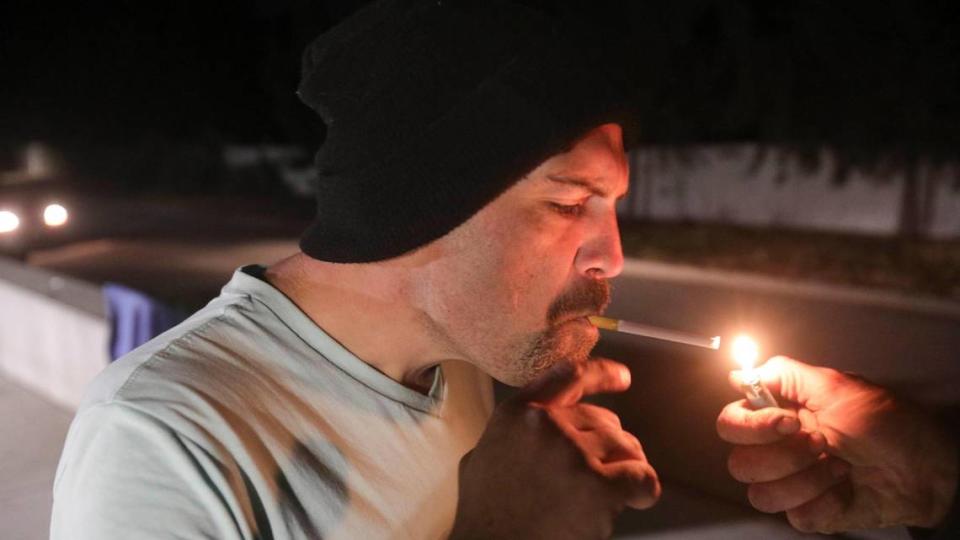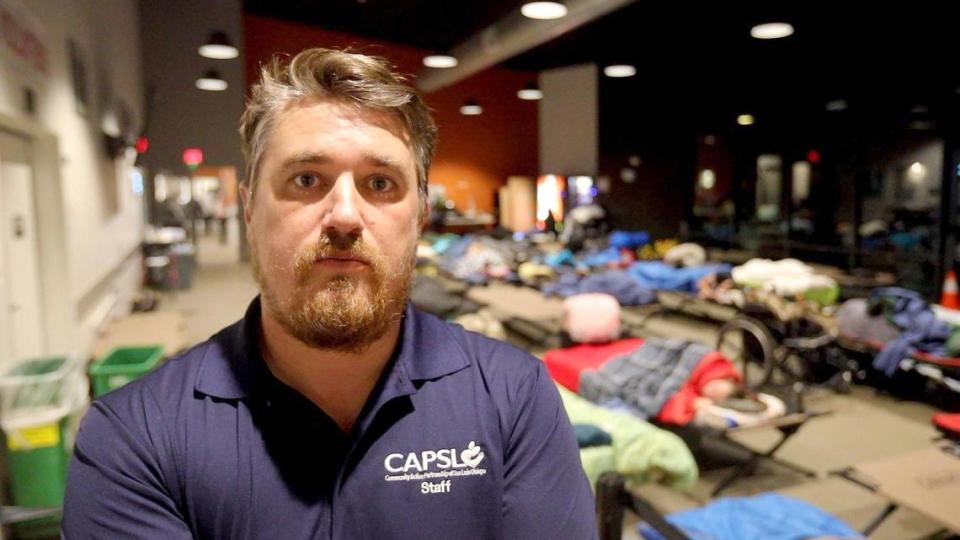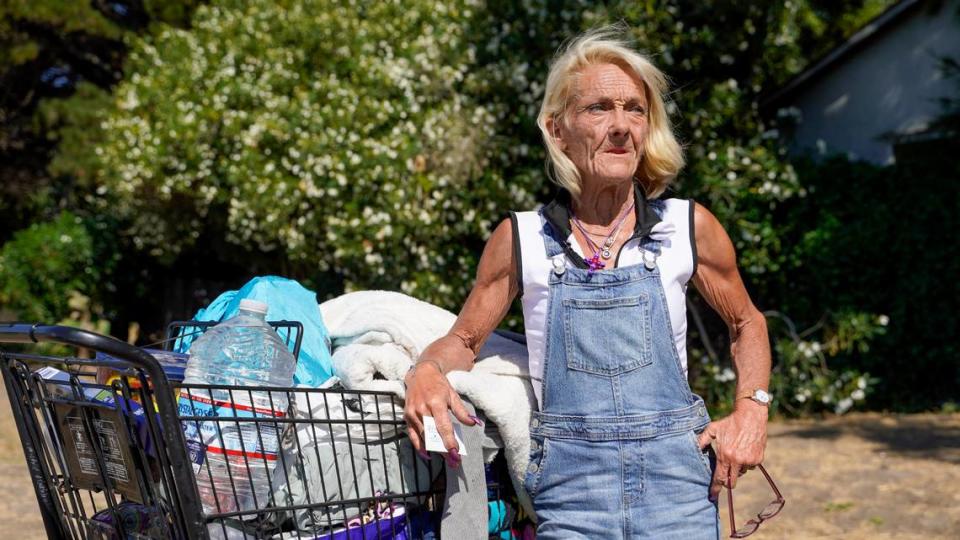‘Everybody’s just desperate’: Cold weather stresses SLO County homeless residents, shelters
Support SLO County Housing Reporting
→ Support reporter John Lynch’s coverage of housing and homelessness in SLO County by donating to The Tribune’s Local Impact Journalism Fund. Go to sanluisobispo.com/donate.
Kris Kaehler was supposed to be in San Luis Obispo for five days.
Instead, he’s been here nearly five months.
“I have a ‘Gilligan’s Island’ story,” Kaehler joked.
Kaehler, a contract electrician, was only supposed to be in San Luis Obispo for less than a week, working on the remodel of the Vons grocery store on Broad Street.
He lives in Big Bear, around five hours from San Luis Obispo, and is no stranger to being on the road for extended periods of time from his background as a petition gatherer.
However, he had never gone homeless in all his years of traveling for work, he said.
That all changed when Kaehler was involved in a car accident in San Luis Obispo, which damaged his car so badly that it was not road safe, he said.
Now, each night around 7, Kaehler and his service dog, Chewbacca, can often be found at the 40 Prado Homeless Services Center, finishing up their chores and getting ready to take their spot in the shelter’s warming center program.
However, while Kaehler has been able to keep a roof over his and Chewbacca’s heads during some of the colder nights of the winter season, not all homeless residents in San Luis Obispo County have been as lucky.
As the falling temperatures chill even the sunniest corners of San Luis Obispo County, homeless residents’ few shelter options are under more demand than usual, local service providers said.

What is staying at a warming center like?
In Big Bear, Kaehler said he had been living in room in a hotel owned by a friend between his construction jobs in exchange for free handyman work around the property, but in the five months he’s spent in San Luis Obispo, he’s lost that room, leaving him homeless.
Before he was placed in 40 Prado’s Warming Center in late November by an outreach worker with Good Samaritan Shelter, Kaehler said he had spent around five nights sleeping in his car around San Luis Obispo, enduring the elements and dodging police officers.
Normally in this situation, he would have been able to stay with his girlfriend, who lives in affordable housing in Santa Maria and is pregnant with Kaehler’s child, he said.
However, he said he’s not allowed to stay with her because he was asked to leave by a case manager who overheard an argument between Kaehler and his girlfriend.
Without many alternatives, he’s started staying at 40 Prado during the day and night, looking for jobs and planning his next moves.
Kaehler said he’s been permitted to stay at the facility during the day and the warming center at night until he can get a spot in 40 Prado’s transitional housing program or finds a housing solution for himself.
Since starting his time at 40 Prado, it’s become the norm for Kaehler and Chewbacca to help set up some of the warming center’s cots, then greet the other clients as they arrive, he said.
He said he’s grateful that 40 Prado allows pets at its warming center, a feature most types of shelter doesn’t offer.
“(Chewbacca’s) getting more and more accustomed to the way things are around here,” Kaehler said. “Everybody says he’s the best-behaved dog here by far.”
Kaehler said he’ll be in San Luis Obispo for the foreseeable future while he waits to resolve a driving-under-the-influence charge and puts down roots in the area before the birth of his child next summer.
Until then, with work drying up around the holidays, he said he’ll likely have to rely on the warming center and other services at 40 Prado to keep himself housed.
“With no income coming in, (getting a hotel) is unsustainable,” Kaehler said. “What’s an average night in a hotel nowadays? $80 a night? Back in the late ‘90s, when I first moved out to California, you could get a week in a hotel for that, but not anymore.”

Capacity ‘stressed’ at 40 Prado during winter season
Jack Lahey, director of homeless services at 40 Prado, said that while the facility is almost always filled to capacity regardless of season, the winter season has led to increased demand for shelter.
“We turned away 26 people last night,” Lahey said Nov. 27. “We’ve been operating over our capacity pretty consistently since last September.”
Earlier this year, 40 Prado changed its stay policies from a lottery to a system that guarantees a bed for clients for 90 days, during which clients work with case managers toward a permanent housing solution.
The 90-day model has a capacity of 87 beds for individuals and another 28 for families, with 16 emergency beds on hand to shelter higher-risk clients.
The facility’s warming center — the only program of its kind currently open to clients in San Luis Obispo County — only opens on nights with temperatures below 38 degrees or a chance of rain higher than 50%, Lahey said.
In addition to the 115 90-day beds, 16 emergency beds and 40 warming center cots, 40 Prado has also started taking on clients in overflow space, a policy Lahey said started when the Bob Jones Trail was closed during this year’s winter storms.
Lahey said 40 Prado receives around $20,000 a year from San Luis Obispo County’s general fund to cover the cost of running the warming center, but it’s not enough to run the center for more than a handful of nights.
Since Nov. 1, the warming center and overflow space has sheltered 100 individuals on 19 nights, Lahey said, overextending the facility’s capabilities.
Even setting aside this year’s winter storms and flooding, which saw those numbers spike to 403 individuals sheltered on 121 nights between Nov. 1, 2022, and Oct. 31, 2023, demand for warming shelter and overflow beds at 40 Prado is already higher than normal, according to data provided by the Community Action partnership of San Luis Obispo.
The 100 individuals who have used warming center and overflow beds in the past month are more than in all of the 2020 and 2021 warming center seasons, and the 19 nights of operation have already matched or nearly surpassed the totals from 2020 and 2021.
That’s led Lahey and his staff to be conservative with the number of nights the additional shelter can be open, he said.
“What our plan is now is we’re only doing overflow on non-warming center nights for individuals who are over 65 or medically fragile, and we cap that around eight (beds),” Lahey said. “We’re gonna work on getting those folks into our dorm beds, and then at least temporarily halt the overflow program, because we just don’t have sustainability putting out 20 beds every night on top of what we’re already doing.”

Shelter facilities struggle to keep up with demand
Since spring 2023, the shelter has also been forced to contend with extremely limited shower and restroom capacity as many of the appliances 40 Prado opened with were not built for long-term, industrial use, Lahey said.
In recent months, only half of tje shelter’s 10 main showers have been functional at a time, with staff at 40 Prado resorting to scheduling 15-minute showers in the functioning women’s bathroom, Lahey said.
Repairs to the restrooms only got underway in recent weeks, Lahey said, which involved re-tiling the showers and completely gutting and replacing the men’s showers at a cost of around $100,000 in total.
Delays in permitting and an initial lack of money pushed the repairs down the road longer than needed, Lahey said.
“We were initially delayed because we didn’t have the money to do it,” Lahey said. “When we got about 50% of the money, we said, ‘Screw it, we’re gonna do it and try to fundraise for the rest.’””
Though 40 Prado’s laundry machines are currently working, they are prone to breakdowns, forcing CAPSLO to raise funds to make long-term improvements to the laundry facilities, Lahey said.
Few warming center options available outside of SLO
Elsewhere in San Luis Obispo County, homeless residents have fewer overnight shelter options to choose from.
In the South County, 5Cities Homeless Coalition executive director Janna Nichols said her organization has the plans and funding to establish a warming center but are waiting on a location.
The nonprofit has operated warming centers for South County residents since 2015 at a series of different locations, but had not found a permanent location for the program until recently, Nichols said.
This year, 5CHC is looking to open a permanent location for its warming center in Arroyo Grande after the Arroyo Grande City Council voted unanimously at its Sept. 26 meeting to allocate $100,000 of American Rescue Plan Act funds to 5CHC, Nichols said.
The permanent location in Arroyo Grande has been identified and is currently undergoing renovations, but won’t be ready to shelter clients until January, she said.
“We thought we had an alternative temporary site, and then we had problems with it,” Nichols said. “Now, we have approached a second church, they have said yes, and we are just going through the final negotiations now and hope to have it up and running (in Arroyo Grande) shortly.”
Nichols said while warming centers are a needed resource for unsheltered people during cold conditions, demand in South County isn’t as high as in San Luis Obispo or North County.
Last year was the exception, she said, as the winter storms and flooding kept 5CHC’s warming center open 58 nights, serving 117 unique visitors.
While the permanent location 5CHC is currently working to secure can host as many as 34 people and the temporary location can hold around 20, Nichols said its rare to see more than 10 to 15 people using the warming center each night, and 5CHC has never needed to turn away a client.
“People are not quick to give up their real estate and move their stuff,” Nichols said. “It’s when we have heavy storms and it’s incessant that we have more and more folks come in, and obviously if we reach that point, we’ll be dealing with trying to find secondary sites.”
In the North County, El Camino Homeless Organization director of operations and management Austin Solheim said his organization’s Atascadero and Paso Robles shelters don’t necessarily see a spike in the number of people seeking services but are far more likely to see more daily visits from clients seeking shelter, food and clothing.
ECHO opens its conference rooms and shared spaces and provides hot beverages on cold days, Solheim said, but it doesn’t operate a dedicated overnight warming center, Solheim said.
In the winter, ECHO also distributes winter packages to homeless residents through its outreach case management, including water, snacks and winter clothing, Solheim said, in addition to its meal service each night at both shelters.
“Extreme weather can always cause someone that is in a situation of homelessness to be in danger,” Solheim said. “During the cold specifically, the biggest one that always comes up is hypothermia. It’s also important to make sure that individual has enough food as well — you burn more calories in the cold (because) your body’s working harder to stay warm.”

Unsheltered resident: Encampments should be left alone in winter
The danger posed by cold temperatures is evident in San Luis Obispo County’s homeless encampments.
Debbie Marino, a homeless resident of San Luis Obispo County, said in past years, she’s stayed outside in temperatures around 20 degrees at their coldest, and has seen friends suffer from hypothermia and other illnesses as a result of the weather.
Marino said she doesn’t have consistent shelter other than the occasional stay at 40 Prado’s warming center, and is living with a terminal cancer diagnosis that causes a high level of physical stress.
She’s lived all over San Luis Obispo County and has found shelter alone and in larger encampments, she said.
Though living in encampments carries its own unique problems, such as fear of property confiscation by law enforcement, fire risk and higher chance of catching illnesses, Marino said sometimes staying in an encampment can be the only way to stay warm and relatively safe in the winter.
“Encampments have a tendency to move outside of town in the summer because it gets so hot and stuffy — everybody can spread out, and they don’t have to worry about being in a safe enclosure,” Marino said. “In the wintertime, it becomes much more congested. You find one person who’s found a spot and they’ve been there for two days and they haven’t been bothered by the cops, before you know it, you’ve got 40 people on it.”
Solhiem said this is a common practice among homeless populations, regardless of location.
“You’ll see a lot more people tend to group up during these winter months, just so that they can stay warm and stay connected and have someone looking out for them as well,” Solheim said.
Marino said she and other homeless individuals can also face discrimination at potential sources of shelter such as motels.
On a cold night three weeks ago, she was denied a room at a motel because her mailing address was 40 Prado Road, even though she had the money to pay for a room, she said.
Marino said because San Luis Obispo doesn’t have the shelter space for all unsheltered residents, it should allow encampments to exist through the winter, but with some oversight and collaboration between the encampment residents and city government.
As the weather gets colder, places to find shelter become scarce and resources are stretched thin, leading to more conflict between homeless residents, Marino said.
“Right now, it’s very dangerous because everybody’s just desperate,” Marino said. “There’s safety in numbers.”

